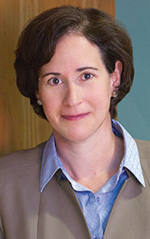It’s Not Just about Paris: International Climate Action Today
There is a great breadth and depth of official and unofficial activity around the world aimed at meeting the climate change challenge.
BY KAREN FLORINI & ANN FLORINI
Further Reading
For more information on global climate change issues and initiatives, visit the following sources:
I Beg to Differ: Taking Account of National Circumstances Under the Paris Agreement, the ICAO Market-Based Measure and the Montreal Protocol’s HFC Amendment—www.bit.ly/TakingAccount.
Debating Carbon Taxes with Oren Cass and Bill Gates—www.bit.ly/DebatingCarbonTaxes.
Climate Change Science and Global Warming Misinformation—https://skepticalscience.com.
The world no longer waits for U.S. leadership on climate. In 2014, astute U.S. diplomacy helped foster a U.S.-China joint announcement that in turn made possible the breakthrough Paris Agreement in 2015. But with that agreement now in force, businesses and cities already deeply engaged and evidence of climate impact more compelling by the day, U.S. disengagement is unlikely to leave a leadership void for long. Already the European Union is stepping into the role of China’s chief dance partner on climate, leaving the United States on the sidelines of a projected multitrillion-dollar market for climate-friendly solutions.
Indeed, in the run-up to the Trump administration’s June 1 announcement that it would withdraw from the Paris Agreement—an announcement replete with gross mischaracterizations of the agreement’s actual provisions—businesses from Exxon to General Mills to Intel called for the United States to remain a party to the agreement. They did so not least because they believe their ability to compete effectively in global markets will be undercut by Washington’s abandonment of its seat at the climate-policy table.
Climate change is also increasingly seen as a security issue. In its 2015 report, National Security Implications of Climate-Related Risks and a Changing Climate, the Department of Defense identified climate change as “an urgent and growing threat to our national security, contributing to increased natural disasters, refugee flows and conflicts over basic resources such as food and water.” Moreover, Defense noted that these impacts “are already occurring, and the scope, scale and intensity of these impacts are projected to increase,” aggravating “existing problems … that threaten domestic stability in a number of countries.”
Although the Paris Agreement has drawn the lion’s share of recent international climate headlines, it is far from the only forum in which Americans can, and do, address climate issues. A glorious profusion of state, non-state and hybrid entities in the United States and elsewhere is demonstrating impressive ingenuity in relevant policy and technology. But this abundance of loosely connected actors and initiatives makes it difficult to understand how many fronts exist in the battle against catastrophic climate change. To help reduce the confusion, this article offers a tentative taxonomy. For context, some basics of the climate issue and of the Paris Agreement itself are first briefly summarized.
The Climate Science Context and the Paris Agreement
Despite occasional claims to the contrary, the physical science underlying concerns about climate change is well established. Carbon dioxide traps heat (i.e., energy) in the atmosphere, a physical property readily measured through spectroscopic analysis. Fossil fuels and organic materials such as wood release carbon dioxide when combusted, increasing atmospheric carbon dioxide levels and trapping more energy in the atmosphere. This results not only in higher global average surface temperatures; it also, in effect, puts weather on steroids, with impacts that include more-intense droughts and deluges. In addition, as higher temperatures trigger thermal expansion of water and melting of land-based glaciers and ice sheets, average sea levels rise.
How big will these impacts be and how fast will they come? Will they be modest and slow enough that most societies can adapt (despite disproportionate consequences for some locales and the poor)? Or will big changes come swiftly, with wrenching consequences that destabilize entire regions and eventually the world economy? The answer depends primarily on how much more carbon pollution is loaded into the atmosphere. Beyond that, the complexity of the planet’s climate system makes precise answers impossible, at least for now, so projections of temperature increases and impacts are best expressed as probability ranges rather than a single point. The higher but all-too-plausible ends of those ranges paint a picture of brutal temperature swings, massive droughts and resulting food insecurity, and rising sea levels that devastate coastal cities around the globe.
Nor is it plausible to wait and see whether impacts approach intolerable levels, and only then start reducing emissions. Excess carbon dioxide persists in the atmosphere for centuries and some tipping points, such as large-scale melting of polar ice sheets and carbon-rich Arctic permafrost, would be essentially irreversible, so impacts would intensify for many years even after emissions were curtailed. Socioeconomic factors also make turn-on-a-dime responses infeasible: Reconfiguring the world’s fossil-fueled infrastructure for energy, transport and industry is the work of decades, as is upgrading energy efficiency in billions of energy-consuming buildings and appliances. (While some researchers are exploring “geoengineering”—artificial manipulation of the earth’s climate—to rapidly deflect warming, its practicability remains unclear, to say nothing of its potential unintended consequences.) And the argument that our descendants will be rich enough to readily adapt to the consequences of a changing climate ignores the very real possibility that severe climate change will itself derail future economic growth.
The good news is that the cost of low-carbon energy, particularly renewables, has plummeted over the last decade, spurring increased deployment. Globally, renewables now account for the majority of new electric-power generating capacity. The bad news? Fossil fuels today still provide more than 85 percent of the world’s total energy supply. Dramatic emission reductions require not only that existing infrastructure be reconfigured, but also that new development take a low-carbon pathway.
Growing recognition of the urgent need for climate action prompted enough countries to join the Paris Agreement by October 2016 to reach its entry-into-force threshold—55 countries representing 55 percent of global emissions—with near-unprecedented speed, even as the world was experiencing the hottest year on record for the third year in a row. (In September 2016, President Barack Obama used a combination of inherent presidential authority and authority conferred by legislation and treaty to enter into the Paris Agreement, designating it an executive agreement not requiring Senate advice and consent.)
Though by no means perfect, the Paris Agreement constitutes a major step forward. It articulates a global goal of keeping temperature increases to “well below” two degrees Celsius above pre-industrial levels (with efforts to limit warming to 1.5 degrees), a target initially proposed by scientists as avoiding the worst effects of climate change.
The Paris Agreement neither dictates a U.S. emissions target nor imposes financial contributions; targets are nationally determined, and contributions are voluntarily decided by each country.
Contrary to the assertions President Donald Trump made when announcing the U.S. withdrawal, the Paris Agreement neither dictates a U.S. emissions target nor imposes financial contributions; targets are nationally determined, and contributions are voluntarily decided by each country. Rather, the agreement’s legally binding elements essentially involve submitting an updated national target on a five-year cycle—a target that is entirely self-determined, and for which there is no penalty if exceeded—and continuing to provide information that the United States already makes public. Indeed, the agreement extends emission-reporting requirements to developing countries (with flexibility for those that need it in light of their capacity), eliminating a prior disparity on information sharing.
But though the targets are not legally binding, they can provide useful signals to other countries and to investors, inventors and entrepreneurs. And many countries are acting to provide such signals. Singapore, a country whose economy depends significantly on oil refining and trading, announced in February that, as of 2019, it will institute Southeast Asia’s first carbon tax on the country’s largest emitters. Over the past year, India has added twice as much renewables capacity as coal capacity. Even Saudi Arabia, the world’s top exporter of crude oil, launched the first stage of a planned $50 billion renewable-energy procurement program in early 2017.
One of the more unusual features of the Paris Agreement (or more accurately, its accompanying Decision) is its emphasis on the role of non-state actors: the private sector, subnational governments, environmental and development advocacy groups, the faith community, trade unions, labor, youth groups, academia and civil society writ large. Among other provisions, the Decision calls for a high-level event featuring non-state actors at each annual climate negotiations conference through 2020.
In addition, to help strengthen synergies among these groups, the Decision provides that a “champion” will be appointed each year by the nation that is taking up the presidency of the annual climate negotiations. Each champion serves for two years, overlapping for a year with the champion appointed in the prior year. At the 2016 climate negotiations, the inaugural champions (from France and Morocco) launched the Marrakech Partnership for Global Climate Action to provide a “consistent and structured approach” for advancing the work of non-state actors. In May 2017, the current champions (from Morocco and Fiji) issued additional details of the structured approach.
Climate Action Beyond the Paris Agreement: A Taxonomy
The Paris Agreement is the central element of international action on climate, but there are innumerable others. Some of these elements are associated with the U.N. Framework Convention on Climate Change, under which the Paris Agreement was adopted, but state and non-state actors alike are engaged on climate issues in ways that go far beyond the Paris provisions. Indeed, the variety of state, non-state and hybrid entities engaging on climate issues is cause for both hope and confusion. To help dispel the latter, we offer the following somewhat idiosyncratic taxonomy to map the various kinds of activities now underway, with some illustrative but far from comprehensive examples.
New examples are already arising in the United States in the wake of Pres. Trump’s Paris withdrawal announcement, such as the United States Climate Alliance comprising U.S. states that aim to reduce emissions consistent with the national target that had been previously announced by Pres. Obama. As of this writing, 12 states accounting for more than a quarter of the U.S. population and nearly a third of its GDP had joined this alliance.
The taxonomy described below has three main branches: (1) Paris Agreement “Relatives”—entities that are mentioned in or that are explicitly focused on implementation of the Paris Agreement; (2) Non-Paris Multilateral Initiatives, some of which also involve non-state actors; and (3) Non-State Actor Initiatives in the private sector, in the subnational government sector or in civil society (some of these initiatives involve national governments, as well). Examples from each of the main branches and sub-branches follow.
Paris Agreement “Relatives”
Clean Technology Center & Network. CTC&N, the operational arm of the UNFCCC Technology Mechanism, promotes the “accelerated transfer of environmentally sound technologies for low-carbon and climate-resilient development” in response to specific requests from developing countries for advice on technologies, capacity building and policy, legal and regulatory matters.
NDC Partnership. Launched at the 2016 UNFCCC climate conference in Marrakech, the partnership is chaired by Morocco and Germany. It is a coalition of developing and developed countries and international institutions working together to help developing countries achieve their climate objectives. In particular, the partnership aims to help countries navigate the “vast, fragmented array” of technical and financial support through its knowledge products such as the NDC Funding and Initiatives Navigator database and the NDC Toolbox Navigator.
Green Climate Fund. Although launched under the auspices of the UNFCCC, the GCF operates as an independent organization with a separate board comprised of 12 developed and 12 developing nations and its own secretariat in South Korea. The GCF is intended to be a principal mechanism for providing developing countries with support for low-carbon, climate-resilient development and adaptation. To date, 43 countries have pledged more than $10 billion, including $3 billion from the United States, of which $1 billion has been paid. GCF uses multiple financial instruments, including grants, concessional loans, debt, equity and guarantees, and has a dedicated private-sector facility.
Non-Paris Multilateral Initiatives
Formal Agreements. Two other climate-relevant international agreements were successfully negotiated in the months following adoption of the Paris Agreement but independent of it:
Kigali Amendment to the Montreal Protocol. Adopted in October 2016, the amendment provides for a global phase-down of certain hydrofluorocarbons (HFCs), which are chemicals used chiefly in refrigeration and air conditioning as substitutes for ozone-depleting substances. These HFCs are extremely potent heat-trapping gases (up to several thousand times more powerful than carbon dioxide). Implementation of the amendment will prevent more than 0.5 degrees Celsius of warming this century, a significant contribution toward the Paris Agreement’s goal of holding warming to less than 2 degrees.
Carbon Offsetting and Reduction Scheme for International Aviation. CORSIA was adopted in October 2016 by the International Civil Aviation Organization to avoid post-2020 growth in carbon dioxide emissions from international civilian flights that depart from one country and arrive in another. CORSIA is the first international agreement to limit the total emissions of an entire global industry sector.
The good news is that the cost of low-carbon energy, particularly renewables, has plummeted over the last decade.
Additional Forums. In addition to formal multilateral negotiations, processes such as the annual G-20 and G-7 gatherings have often addressed climate and energy topics, as have regional groups such as the Arctic Council (the eight countries having territory within the Arctic Circle). Specialized entities also focus on particular topics. Examples include:
Clean Energy Ministerial. CEM is a minister-level forum composed primarily of large emitters (among them the United States, China, India, Russia, Japan and Indonesia, as well as several European and Nordic nations). CEM’s 24 member countries account for 75 percent of the world’s greenhouse gas emissions and for about 90 percent of global clean energy investments. CEM hosts an annual forum for ministers, and sponsors technical programs on key topics such as highly efficient appliances and lighting, smart grids and low-carbon cooling, many of which involve the private sector as well as governments.
Climate and Clean Air Coalition to Reduce Short-Lived Climate Pollutants. Although carbon dioxide is the principal greenhouse gas, other substances also contribute significantly to climate disruption. Of these, several are more potent but less persistent than carbon dioxide, most notably methane, black carbon (soot) and some HFCs. CCAC—a hybrid of more than 50 countries and more than 50 nongovernmental and intergovernmental organizations—operates seven sectoral programs and several cross-cutting programs aimed at reducing emissions of these substances.
U.N. Environment Program Inquiry into the Design of a Sustainable Financial System. The UNEP Inquiry catalyzes engagement of high-level finance policymakers in a process aimed at revamping financial regulation to support the transition to low-carbon sustainability. Its reports and national engagement processes prompted China to set up a Green Finance Study Group in the G-20 and fostered conversations across the World Bank, IMF and U.N. with the private finance sector.
Non-State Actor Initiatives
As with the prior sections, the following examples are not comprehensive. Rather, they are illustrative of the range of climate-based activities organized by non-state actors. Many more are listed in the Non-State Actor Zone for Climate Action (climateaction.unfccc.int), a database outlining more than 12,000 commitments by businesses, subnational governments and other non-state actors to reduce emissions.
Private Sector Initiatives
Breakthrough Energy Coalition. Announced at the 2015 Paris climate negotiations, the coalition was formed by Bill Gates and other wealthy investors to deploy “patient and flexible” capital for new energy technologies. The coalition launched a Breakthrough Energy Ventures Fund of more than $1 billion in 2016 to increase the speed and scale at which promising energy developments are brought from the lab to the marketplace, through long-term investments with the potential to reduce greenhouse gas emissions by at least half a gigaton (one billion tons).
Oil/Gas Climate Initiative. Led by the CEOs of 10 companies that jointly produce 20 percent of the world’s oil and gas, the initiative organizes collaboration on action to reduce the sector’s greenhouse gas emissions.
Walmart. In April 2017, the world’s biggest retailer launched an initiative to work with its suppliers to cut a gigaton of emissions by 2030. The company has also pledged to reduce its own direct emissions by 18 percent by 2025.
Subnational Government Initiatives
Under2 MOU. Known formally as the Subnational Global Climate Leadership Memorandum of Understanding, the Under2 MOU provides that signatories will reduce greenhouse gas emissions by 80 to 95 percent from 1990 levels, or limit their emissions to two tons per capita annually, by 2050. A total of 170 jurisdictions from 33 countries have signed or endorsed the MOU, representing 16 percent of the global population and 37 percent of the global economy.
C40 Climate Leadership Group. A network of more than 80 megacities and innovator cities, C40 emphasizes urban action to reduce greenhouse gas emissions. Its member cities are home to more than 600 million people representing one quarter of the global economy.
Civil Society Initiatives
A prodigious array of civil society organizations, from academic consortia and think tanks to activist NGOs, engages on climate issues. For many, climate is a primary or exclusive focus, while for others it is part of a broader environmental, development or faith-based agenda. Such groups also vary considerably in their geographic scope: some are active locally, others at the provincial/state level, still others nationally or globally.
Most are involved in formal or informal coalitions, or are themselves coalitions of groups, such as We Mean Business (comprised of business-facing NGOs that work directly with companies and investors), the Climate Action Network (an umbrella group of more than 1,000 environmental NGOs from around the globe, with formal regional networks in multiple locations) and Galvanizing the Groundswell of Climate Actions (a convener of dialogues among various cohorts of non-state actors, including academics, businesses, cities and non-governmental groups).
These initiatives also vary widely in resources, from shoestring operations to well-established organizations with multimillion-dollar annual operating budgets. Increasingly, organizations founded in developed countries have launched branches or sister organizations in developing nations, particularly those with substantial emissions.
What’s Next on Climate Change?
The world is moving forward on climate change, with or without U.S. government involvement. Given the realities of a warming climate, the United States will not be able to avoid the issue for long. Even prolonged inaction is not going to change what the rest of the world does. Indeed, the U.S. announcement is already stimulating action by our own businesses, cities and states. But it will leave the federal government without a seat at a very big table.
Rather than leading, the United States will be scrambling to catch up from a withdrawal decision that ignored the Paris Agreement’s actual terms and that has demonstrably undermined U.S. credibility internationally, as the world proceeds without us to create the low-carbon economy of the 21st century.












